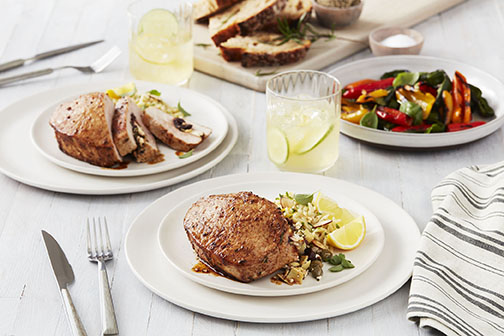
Mediterranean stuffed pork chops
With Herbed Orzo and Grilled Bell Peppers
Try a twist on the classic pork chops with this delicious Mediterranean stuffing.

Ingredients
4 Open Prairie® Natural* boneless pork chops (8 oz each)
6 ½ tsp olive oil, divided
2 tsp minced shallots
1 tsp minced garlic
2 Tbsp dry white wine
2 oz sun dried tomatoes, diced
2 oz artichoke hearts, diced
1 ½ oz Kalamata olives, sliced
¾ oz capers
3 oz feta, crumbled
2 Tbsp chopped parsley
2 tsp kosher salt
2 tsp smoked paprika
1 tsp fresh cracked black pepper
Instructions
- Preheat oven to 350°F.
- In medium saute pan, heat 1 ½ teaspoons olive oil over medium-high heat.
- Add shallots and garlic; saute 2 to 3 minutes or until tender. Add wine; cook 2 minutes longer.
- Remove pan from heat; add tomatoes, artichoke hearts, olives and capers. Stir stuffing mixture well; transfer to a plate. Cool in refrigerator while prepping pork chops.
- Pat pork chops dry. Slice each chop horizontally with a boning knife almost to the other side of the chop.
- Combine feta and parsley with cooled stuffing mixture; fill each chop with a quarter of mixture.
- Coat each chop with 1 teaspoon olive oil; sprinkle each with salt, paprika and pepper.
- In large saute pan, heat remaining 1 teaspoon olive oil over high heat. Sear chops 3 to 5 minutes per side or until golden.
- Transfer pork chops to rack over a shallow roasting pan. Roast chops for 15 to 20 minutes or until an internal temperature of 130°F. Let chops rest for at least 10 minutes before serving.
- For herbed orzo: In medium saucepan, bring water to a boil. Stir in orzo; boil for 6 to 8 minutes or until al dente.
- Drain orzo; transfer back to saucepan.
- Gently mix in basil, chives, thyme, parsley, oregano, olive oil, lemon juice and zest, salt and pepper.
- Sprinkle orzo with toasted almonds before serving.
- For grilled bell peppers: Preheat grill on high.
- Cut peppers into medium-size pieces. In large mixing bowl, toss peppers with olive oil, salt and pepper.
- Grill peppers 3 to 5 minutes on each side or until tender.
- Remove peppers from grill; sprinkle with basil before serving.
Ingredients
Makes: 4 servings
Prep time: 15 minutes
Cook time: 10 minutes
Ingredients:
3 qt water, salted
1 ½ c orzo
2 Tbsp chopped basil
1 ½ Tbsp chopped chives
2 tsp thyme leaves
2 tsp chopped parsley
1 tsp chopped oregano
2 Tbsp olive oil
1 ½ Tbsp lemon juice
2 tsp lemon zest
1 tsp kosher salt
½ tsp fresh cracked black pepper
¼ c toasted almond slices
Makes: 4 servings
Prep time: 10 minutes
Cook time: 10 minutes
Ingredients:
24 oz red, yellow, and green bell peppers
1 Tbsp olive oil
1 tsp kosher salt
½ tsp fresh cracked black pepper
3 Tbsp chopped basil
Instructions
Nutritional analysis based on the suggested serving size of main protein dish and ingredients, excluding side items.